 |
| All Images Courtesy of Arrow Video/MGM |
On the list of great schlock maestros of B-movie cinema, most everyone has heard the names of William Castle, Roger Corman, and Lloyd Kaufman. But I would argue that the fourth name everyone should know, rounding out that Mount Rushmore of American B-movies, is Charles Band. Band established himself in the late-1970s/early-1980s as something of a next-generation Roger Corman for the video store era; he continues making movies to this day (for an increasingly niche audience with increasingly smaller budgets, truth be told), but in the 80s and 90s he was the king of very fun B-movie trash - and I mean trash in the most endearing and positive way. He was instrumental in the home video boom of the late-70s and early-80s as the founder of two different fan-favorite genre-focused VHS labels, Media Home Entertainment and Wizard Video, and he founded two production companies which became beloved by genre fans for the particular type of low-budget-but-still-visually-impressive movies they produced in large volume. The Charles Band production company with probably the biggest pop-cultural footprint was his 1990s studio Full Moon Entertainment, which in its glory days as a Paramount imprint dominated the world of straight-to-video genre films with franchises like Puppet Master, Subspecies, and Trancers (Full Moon is still alive and kicking, although personally I think the magic of those first few Paramount years is long gone, along with most of their budgets). But in the 1980s he founded Empire International Pictures, which produced a lot of films which were released theatrically before becoming video-store and late-night-cable mainstays. Re-Animator and From Beyond are undoubtedly the most beloved of these, with Ghoulies and the original Trancers also having been major early calling-cards, but Empire produced a lot of movies that were very very fun, with a very particular B-movie brand identity.
Now, Arrow Video is honoring the legacy of Empire Pictures with what will hopefully be the first of several box sets gathering their films into a boutique anthology collection: Enter the Video Store: Empire of Screams. The set contains five films from the Empire catalog, presented chronologically from one of their earliest productions (1984's The Dungeonmaster) to one of their last (1989's Robot Jox). Four of the five films are newly restored by Arrow in 2k restorations from the best available sources, and one of them (Arena) is being presented in HD for the first time, after years of all 35mm elements being thought lost. All five films have an array of impressive special features, and the set comes in a very cool, video-store-themed hard box with a book of essays; indeed, by the far the most academically-rigorous study, not to mention the most high-end home video treatment, that the Empire Pictures catalog has ever received. All of these films have had at least minor cult followings over the years (one of them, Dolls, previously got a very swanky Collector's Edition from Scream Factory), but this is a massive upgrade for all five titles, and the presentation is very unique, with Arrow presenting the Empire Pictures catalog as a united body of work worthy of consideration as a whole made by a recurring team of B-movie auteurs.
THE FILMS:
The Dungeonmaster (1984):
The chronological journey through the Empire Pictures catalogue begins in 1984 with The Dungeonmaster: one of the very first films the studio produced, along with fellow 1984 productions Trancers and Ghoulies. These three films all became more or less instant cult favorites among the B-movie midnight-show/video-store crowd, and made Empire Pictures immediately a name to watch for those who love these kinds of films. The opening credits to The Dungeonmaster give an instant primer on how and why Empire (and later Full Moon) productions all had such a particular flavor and sensibility: they truly were all made by a recurring network of filmmakers and artists who knew how to work together, and shared some common mentalities. And since the whole concept of The Dungeonmaster is basically an anthology film with each segment helmed by a different director, almost all of those names are present here. Creature effects artist and director John Carl Buechler (Friday the 13th Part VII), stop-motion effects artist and director David Allen (Young Sherlock Holmes), cinematographer Mac Ahlberg (Re-Animator), editor and director Ted Nicolau (Subspecies), and of course Charles Band himself wearing many hats (including a "story by" credit despite not being the actual screenwriter - that's something you see a lot in Empire and Full Moon films). Despite being one of the earliest Empire films, it feels like the gang is mostly all here.
The Dungeonmaster is an odd kaleidoscope of a movie, but quite a fun one. The basic idea clearly seems to be for the various Empire Pictures effects artists and filmmakers to try as many cool things as quickly as possible, in a genre-hopping fever-dream of an anthology(ish) story. The setup is basically like a video game (or an especially chaotic, time-and-location-hopping Dungeons & Dragons campaign, as the title implies): seven levels and a final boss, with each of the levels being something more or less completely different. The premise is that our hero, Paul (Jeffrey Byron), is a computer science genius who has created the first AI computer and connected it to his own brain, making him a kind of nerdy superhuman - and this has caught the attention of an evil sorcerer (Richard Moll, Night Court) who has been scouring time and space looking for worthy opponents to fight for fun, to soothe the boredom of immortality. So the sorcerer kidnaps Paul and his girlfriend (Leslie Wing), and tells him he must survive and outwit seven different challenges, or both of their souls are forfeit.
It's... an incredibly contrived and silly premise, even by Charles Band standards, but it's also a utilitarian plot device designed to get our hero into the seven separate short segments as fast as possible, with Moll as an evil Cryptkeeper-esque MC. The challenges are eclectic, are all based around a different effects technique or sci-fi/fantasy/horror trope, and are generally all quite fun. John Carl Buechler's challenge with an army of sword-wielding zombies shows off his very cool makeup effects, not to mention an unexpected cameo by a Ghoulies puppet doing double-duty (Charlie Band definitely knows how to save money!). A heavy metal themed segment featuring WASP in a cameo is a lot of campy, Elm Streetish fun. A segment with a giant stone god shows off David Allen's stellar stop-motion work, albeit too briefly.
The issue with most of the segments is that they feel oddly short: with seven of them crammed into just an hour of runtime, after fifteen minutes of setup (yes, the film is a very short 73-77 minutes, depending on which version you watch - more on that later), most of them feel too abbreviated to be actual anthology stories. A time-travel slasher segment set in New York City is by far the longest and most in-depth of them, and actually manages to feel like a proper, full story (and interestingly enough, it was written by star Jeffrey Byron), and unsurprisingly it is the best of the bunch. Most of the rest are disposable but fun - brief shows of cool effects and art design and fun ghoulish ideas, but that really is about it, like short levels in a late-80s video game.
The Dungeonmaster is presented on the disc in three different cuts, although they are all very short, and the differences between them are relatively minor. All three versions have the segments presented in a slightly different order, although since the film is structured as an anthology that doesn't necessarily make that much of a difference. The pre-release version is the most complete, so it is the obvious one to choose: it has the segments in the order originally scripted, and is totally uncut. The European theatrical version (under the somewhat baffling alternate title Ragewar) is mostly the same as the pre-release version, but some segments are shuffled around and it has a couple shots of nudity trimmed by the censors. The US theatrical cut moves the segments around yet again, and it completely cuts a pre-credits dream sequence present in both of the other versions; a very odd choice, especially since it's not like the film was overlong and needed to be cut for time. None of the changes make or break the film, and ultimately all three cuts are just slight variations on the same basic movie, but there's really no reason to watch any version but the pre-release cut, considering that it is the most complete, and at only 77 minutes it's not as though you have to worry about it feeling padded. All three cuts also use the same new 2k restoration of the interpositive, and they all look excellent.
Overall The Dungeonmaster is a fun but ultimately disposable movie which has a lot of cool stuff in it, but is no more than the sum of its parts. The variety is fun, and it is easy to see why it was a home video hit, but it isn't narratively ambitious so much as it is ambitious in trying to cram in as many genres and styles as possible, and that makes it fairly insubstantial even if it's a good time in the moment. If you go in with modest expectations, this is totally fine: the intention seems less to be a genre epic, and more to be a party movie, which would be a lot of fun for a group of Dungeons & Dragons loving friends to enjoy over drinks, while laughing and cheering on the fantasy-horror silliness. Not a masterpiece, but good, goofy, campy fun, and reasonably successful in what it sets out to do.Score:
Dolls (1987):
Special effects artists John Carl Buechler and David Allen, and cinematographer Mac Ahlberg, return for the second film in the set, 1987's Dolls, which is most notable for being Stuart Gordon's follow-up to his 1985 hit Re-Animator. Right out of the gate, it is immediately apparent that Dolls is in a whole other class from The Dungeonmaster, thanks largely to Gordon's excellent, sure-handed direction and ambition. While The Dungeonmaster was clearly made with a long life in home video in mind, Dolls is very much a big-screen horror movie from frame one. With gorgeously spooky production design, beautiful and very kinetic cinematography, and a menagerie of special effects featuring a whole lot of stop-motion work which must have been very expensive indeed, the production values here are very impressive for an Empire picture. This Old Dark House Gothic horror tale is definitely a top-tier entry in the studio's filmography.
Dolls is a present-day take on the storytelling style of a Grimm fairytale - as a dark, bloody horror story, of course (which the Grimm fairytales really were to begin with, after all). It follows a young girl on a miserable vacation in England with her abusive dad and evil Wicked Stepmother, whose car gets stuck in the mud during a terrible thunderstorm, and who must take refuge in a secluded Victorian mansion. The mansion is owned by a spooky, strange elderly couple (English character actors Guy Rolfe and Hilary Mason), and is absolutely filled with dolls. The elderly man is a dollmaker, and he says that dolls are fiercely loyal to the children who love them, and don't take kindly to adults who are cruel to kids or have forgotten the joys of childhood... As the night goes on, our young protagonist and her cruel parents will learn just how true that is, as the dolls in the house reveal their true nature, and come to life to serve up some justice against the nasty grown-ups...
It's a straightforward setup told with fairytale simplicity, realized by Gordon and company as a Victorian ghost house of long shadows and macabre horrors. The atmosphere is expertly crafted, and Gordon and cinematographer Mac Ahlberg use camera movement very well to create suspense. One could criticize the film for having extremely broad and overstated characters which can sometimes be a bit too much (the parents are cartoonishly evil and cruel, the scaredy-cat manchild supporting character is cartoonish in more of a Scooby-Doo way, and the two punk hitchhikers who are clearly just there to pad out the body count are simply annoying), but since the whole movie is told like a fairytale, the broad characterization more or less works in context, even if it's not my favorite choice. Rolfe and Mason, however, are perfect as the spooky old couple with all the dolls, striking just the right balance of kindliness and menace, and they really anchor the whole film and make it feel somehow plausible.
And then there are the dolls, who are the real stars of the show. The special effects here truly are top-notch, and clearly must have cost a lot. While The Dungeonmaster only had the money for David Allen to make a brief stop-motion sequence, Dolls features a ton of really strong stop-motion work from Allen, which is extremely smooth and lifelike. When the dolls move, they genuinely do look real, and have very strong physicality and characterization thanks to Allen's expert work. Combined with the excellent and very nasty gore effects of John Carl Buechler and Gabe Bartalos, the effects are outstanding all around. If antique porcelain dolls creep you out, you will probably find this movie genuinely terrifying.
Small gripes about the characterization aside, this film is excellent, and definitely in the upper tier of the best Empire Picture productions. It is definitely one of Stuart Gordon's best films as well, although of course Re-Animator remains number one. It is a bit ironic that Charles Band's best-known and most popular franchise, the ubiquitous and much-sequalized Puppet Master, is also about killer dolls, and yet this film is dramatically better than Puppet Master in every aspect, despite not being nearly as much of a household name. Seriously, forget Puppet Master and Demonic Toys - Dolls is head and shoulders above them as the best Charles Band-produced killer toy movie.
Score:
Cellar Dweller (1988):
Next on the set is 1988's Cellar Dweller, directed by (and boasting creature effects by) John Carl Buechler. This one definitely steps back from the more opulent theatrical-feature ambition of Dolls, and gets back to the sort of B-movie made to thrive at the video store that Empire Pictures did so well - and the film does it very well indeed. This and Arena are the only two films in the set that were completely new to me when I received our screener discs, and this one was a delightfully pleasant surprise. This is a very fun creature feature which embraces its campy nature enthusiastically, and is a genuine blast, that was clearly made by horror fans for horror fans, about horror fandom. It has the same type of chaotic and lovingly goofy ghost-house energy as House and House II, with a premise that was repeated a few years later by the iconic Are You Afraid of the Dark? episode The Ghastly Grinner (there's one for the elder millennials!).
Thirty years ago, in a pre-credits prologue, a 1950s horror comic author and illustrator in the EC Comics mold (played by the always-great Jeffrey Combs) uses a book of the occult to get inspiration for the latest issue of his beloved comic series Cellar Dweller. But his use of the book inadvertently summons his ghastly monster into real life, with grisly consequences. Flash forward to the present day: his secluded house is now an artist's colony (run by none other than Lilian Munster herself, Yvonne De Carlo), and everyone assumes that he died in a murder-suicide after going mad. Our hero is a young horror artist (Debrah Farentino) who was inspired to get into comic illustration by her love of the Cellar Dweller series, and who is convinced that her artist hero was innocent. She is at the colony to discover the truth about his death, and get some inspiration to start a horror series of her own, but when she finds the occult book that he used, and inadvertently stumbles upon the exact same idea to use it for inspiration, the creature comes back to life, and her comics start writing themselves - with her and the other artists as its victims.
It is a really fun premise, executed very well on a tight budget, with the creature scenes cross-cut with images of the comic panels illustrating themselves in real time. This conceit makes for an extremely cool art style, and gives all of the creature scenes some impressive stylistic punch even beyond Buechler's reliably memorable effects. This was clearly a low-budget film, and at times you can feel Buechler stretching his resources, but his creature design and animatronics are nonetheless great, and the quick shots of comic panels interspersed with the attacks give the creature a strong presence (not to mention a range of movement and ability to shred its victims) beyond what they could have pulled off with the bulky monster suit alone. Plus, it is really fun how the whole film is about horror media and the love of it, in a way that clearly isn't pandering to fans, but is a love-letter to the genre.
Lead actress Debrah Farentino is very good, making a compelling and strong protagonist who channels the passion of being a horror fan into a believable drive to create: a very different and more serious portrayal of a horror fan than the typical Randy-from-Scream-ish comic relief nerd, which really works. It's also very cool that she's not a horror writer or aspiring director like we see more often in films, but an illustrator, so the film deals with the idea of horror imagery as fine art; very appropriate for a film directed by a special effects maestro. Also, a lot of (if not most) Empire pictures feel like they were made pretty specifically to be watched by teenage boys on late-night cable or VHS, and they tend to be short on good female protagonists who are full-fledged heroes in their own right, and not just skin-showing love interests. Farentino's strong and smart artist breaks that trend, and she does it very well, and also does a great job of representing the women in the horror scene who are just as passionate about the genre and into grisly scares as the dudes.
As with plenty of these films, if you really wanted to you could fault it for having comically broad characters, silly writing, and some dubious acting from the supporting cast. But that's just part of the charm, as far as I'm concerned, especially for films like Cellar Dweller that lean quite deliberately into their own camp and gleefully embrace it. This is the sort of B-movie that knows exactly what it is, and is happily celebrating it. I was very pleased by how much I liked this one - I even prefer it to the comparatively better-known and more popular The Dungeonmaster. Definitely one I would recommend to anyone who loves B-grade creature features!
Score:
Arena (1989):
The box set shifts away from horror and into sci-fi with its fourth film, 1989's Arena, and it also shifts back to a more large-scale theatrical mentality, stretching its (still fairly modest) budget to create the spectacle of a movie clearly meant for the big screen. It takes a pretty comfortable and modest B-movie premise - literally just a classic blue-collar underdog boxing story, but in space - and fills its universe with a menagerie of elaborate, eclectic creature effects and excellent miniature spaceship work to turn it into something pretty memorable, despite its shortcomings. It may not be a great movie, but it does what it does quite well, and has an undeniable B-movie charm, and wound up being another first-time watch that I had a great time with. And without a doubt, the main artists responsible for that are the movie's two very talented creature designers: John Carl Buechler (yet again) and Screaming Mad George (The Guyver).
The plot really is about as standard as they come for a boxing movie that could be set in Philadelphia or Chicago: you've got the young amateur fighter who dreamed of going pro, but gave up on those dreams to become a fry cook cuz the bills have gotta get paid. You've got the underdog promoter who used to believe in the purity and honor of the sport, but has become disillusioned since fighting became all about money, and corruption took over. You've got the crooked big-time promoter with mob ties who rules the industry and rigs matches with doping and dirty tricks to keep himself on top. And of course the amateur fighter and the underdog promoter are going to try and take on the crooked boss and win the championship to restore honor to the game. All extremely by the books to the point of self-parody (indeed, according to screenwriter Danny Bilson in the extras, the original script WAS a genre parody, but the irony got lost in increasingly-straight-faced studio rewrites), except instead of Philly or Chicago it's a space station in the far future, and except for our two intrepid heroes, all of the fighters and most of all the other characters are various species of outlandish-looking aliens. The derivative and dodgy script is really just a problem in the first few minutes though (and it might not be much of a problem at all, depending on your sense of humor about films like this - especially if you're watching with a fun group), as the film struggles to establish itself amid an unsure tone and characters that don't stand out; by the end of the first act the movie finds its footing as it prioritizes its strong points. This is a movie where the plot and characters are really just a framework upon which to drape a very fun world and some really cool fight scenes, and once those elements take center stage, Area is a very good, campy, aesthetically wild time.
From the opening shots, it is absolutely clear what the movie's strong points are, so it's really just a matter of waiting for the formulaic characters to catch up. The film opens with shots of spaceships flying around the universe listening to radio broadcasts of the fights, and then arriving at the space station, and these sequences are excellent displays of practical effects: beautifully detailed models shot with high-frame-rate camera moves, composited against gorgeous matte paintings. It's a great example of lovingly hand-made space-opera visual effects which work wonderfully; truly a lost art, and very impressive considering the budget. Then we get inside the space station where a fight is in progress, and we see that both the fighters and the crowd are an eclectic, highly varied bunch of weird-looking aliens, very much in the Star Wars' Mos Eisley Cantina mold. There must be a couple dozen different types of creatures in this movie, and while they admittedly range from top-notch to downright cheesy (but then again, so do the creatures at Mos Eisley Cantina), so many types of aliens all together in one wild setting is truly a sight to behold, and if you love practical effects you can't help but be charmed.
This opening sets the tone for the whole rest of the film, which never stops filling scenes with weird and eye-catching aliens from John Carl Buechler's effects shop. The whole thing definitely wears its elevator pitch of "what if it was Rocky but with a ton of creatures like on a Star Wars planet?" on its sleeve, but if you're the kind of viewer who eats up practical-effects-driven sci-fi, it hardly matters when there are so many cool sights to take in. While obviously this whole box set so far has been showcasing the effects of John Buechler, it is actually Screaming Mad George who steals the show in this one, delivering the movie's most memorable monster in our hero's top-of-act-2 first big fight. His creature is a massive beast, with ten-foot-long legs, multiple arms, and a huge head with a gaping mouth, brought to life by a combination of a puppeteer inside the suit, and a combination of puppetry and animatronics controlling the rest of its large body - it's incredibly cool, and looks great in motion. Even before seeing his name in the closing credits, I wondered if it was Screaming Mad George's work, since it reminded me (especially in its facial features and facial movements) of the huge "Zoalord" monster he would make for The Guyver two years later. One could question the wisdom of putting the coolest and most technically impressive creature so early in the film, and having the "final boss" reigning champion fighter be a much more conventional guy in a suit, but I suppose it was inevitable, since the monster who is the movie's Apollo Creed equivalent has to actually be present in the film as a fully-mobile character throughout, and George's giant but presumably unwieldy prop wouldn't be nimble enough to serve that purpose. Either way, the movie has some great creature effects, and they definitely are the real stars of the show.
The cast is not nearly as memorable as the creatures, although they do fine. Paul Satterfield is decent enough, and definitely a strong and handsome physical presence, as our hero, but is quite wooden. Claudia Christian does a good job as the underdog promoter who wants to keep the sport honorable, and is definitely the best actor of the bunch, even though actors can only do so much with such thin characters. Hamilton Camp comes on way too strong as the movie's comic relief and quicky wears out his welcome, while Marc Alaimo is appropriately scenery-chewing as the blatantly-evil, Bond-villain-esque fight promoter with big-time Jason Isaacs energy. Buffy the Vampire Slayer and Star Trek fans will get a kick out of seeing a familiar face under the creature makeup of a supporting villain with the very on-the-nose name of Weezil (he's a weasel of a character, and he looks like a literal weasel, get it?!): Principal Snyder and Quark himself, Armin Shimerman. He's a very Snyder-esque character: a weasely little creep with a chip on his shoulder, lurking around the edges of the film looking for ways to either make our heroes' lives miserable, suck up to the real villain of the story, or both; the metatextual layer of knowing his very similar character from Buffy made me smile every time he was on-screen.
Arena is definitely a flawed movie, but overall the positives well outweigh the negatives, and I had a great time with it. Does it struggle with tone and character? Definitely. Is its plot ill-advisedly by the numbers, especially since it chooses to play it straight rather than going with satire? Absolutely. But none of that stopped me from having a great time once it hit its groove, and I even felt legitimately invested in the final fight, even though we are pretty sure we know exactly how it's going to play out. The creature effects and production design are just so fun and cool and eclectic that I found it impossible to not be drawn in and have a great time, and the whole thing has a lovably silly and campy B-movie charm. It may not quite be cult classic material, but it is loads of fun, and one that I would happily recommend to the right kind of B-movie lover.
It is also probably the film in this set whose inclusion is the biggest deal. Yes, Dolls is definitely the one with the most cult cred and the highest level of quality, but Arena is the only film in the bunch making not only its HD debut, but its home media debut in its intended aspect ratio. When Shout Factory put out their edition ten years ago, they wound up having to go DVD-only because it turned out that all 35mm elements of Arena had somehow been lost, and the best available source was a pan-n-scan 4x3 LaserDisc master. All 35mm elements remained lost until Arrow conducted a search for them for this blu-ray - and even after what sounds like an exhaustive search, the only 35mm elements they could find were theatrical prints, which are certainly not ideal. However, Arrow cleaned up Arena beautifully, and this restoration looks great (none of the stills seen here are from this restoration - they are all existing stills from VHS and DVD). It has some imperfections of course, but far less than you might expect. Instances of print damage are very few, although every now and then a scratch does appear, and while part of the last reel looks a bit faded in the lightest areas of the screen, the colors look absolutely great. The detail is also still extremely strong, and while of course sourcing it from a print adds an extra layer of grain, overall this is a stunning restoration considering the source. Arrow must have put a lot of love and care into remastering it, and I really wish they had included an extra about the process. In finding and restoring this print, Arrow really did rescue Arena from the jaws of oblivion, and I'm very glad they did.
Score:
For the effects work:
For everything else:

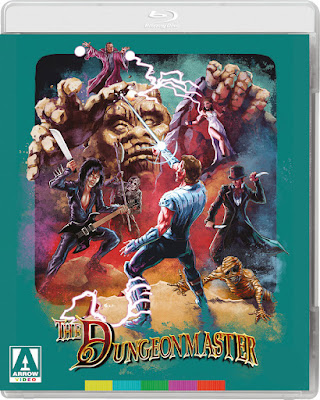
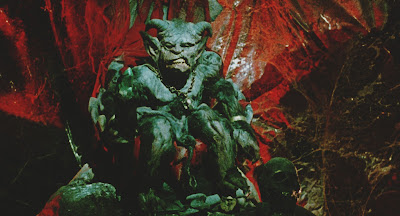


.png)




.png)


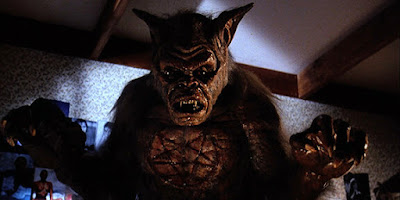
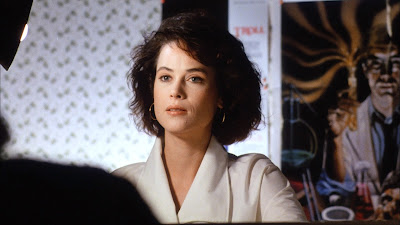
.png)

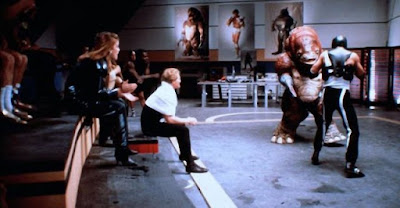

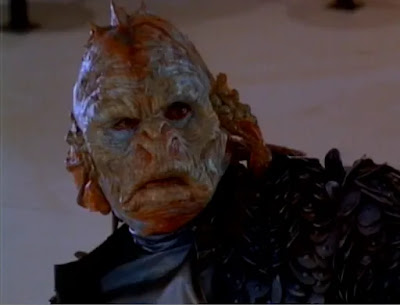

.png)
.png)




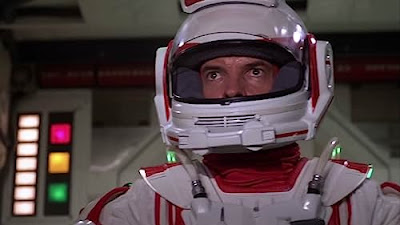
.png)

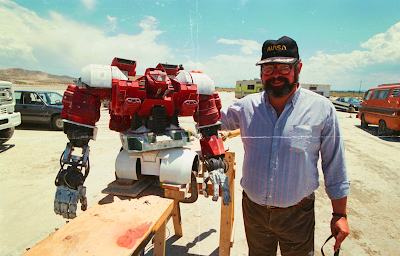

.png)